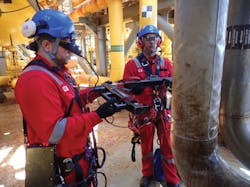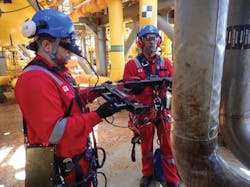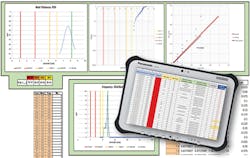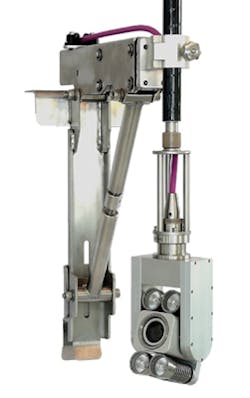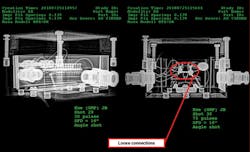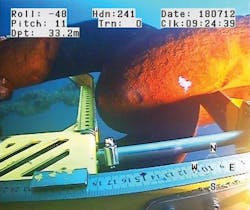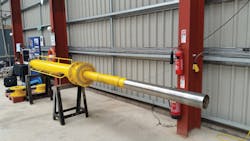Corrosion management critical to long life of offshore assets
Components in all areas at risk
Danny Constantinis, EM&I Group
SEAWATER ENVIRONMENTSare highly corrosive to offshore structures and prevention, early detection and treatment are vital to optimize safety, life cycle cost and uptime. Corrosion control is therefore one of the key issues for offshore assets.
For conversions such as FPSOs, usually based on the hull of a VLCC (Very Large Crude Carrier), corrosion started when the hull was first built – often 20 years earlier or more – and must be dealt with before the asset leaves the yard. Production structures and pressure systems are the ‘big ticket’ items but corrosion also affects onboard electrical equipment and machinery, and these areas too must be considered in a corrosion management strategy.
Real-time radiography. (All images courtesy EM&I)
PREVENTION THE BEST CURE
Life-cycle cost approaches need to align with the differing commercial drivers for project teams and operational teams. Specifying the right materials and implementing an effective corrosion management strategy at the new build or conversion stage is essential, with a balance having to be struck between capex and opex requirements. Life cycle costing should include prevention, inspection, monitoring, inhibition, maintenance, repair, refurbishment and the ‘consequential costs’ of having to shut down the offshore facility or have it come off station.
Prevention of corrosion is often the most effective strategy and careful material selection, coating, cathodic protection and chemical inhibition methods should be adopted effectively. However, longer-term corrosion issues often arise from poor application of these protective measures, the priority being to complete the project to tight time and cost schedules. And when corrosion does occur, maintaining protective systems during the asset’s operating life often takes a back seat, with the main drivers being safety and production levels.
Statistical analysis.
One way for operators to reduce their risk and management costs is to hire service providers that can offer life-cycle based corrosion management services on guaranteed price or subscription-based contracts. An example is a subscription-based service to prevent corrosion of the underwater hull using diverless (retractable anode) Impressed Current Cathodic Protection (ICCP) systems. Conventional ICCP or sacrificial anode systems are likely to have higher and less predictable life-cycle costs simply because of the need for diver or other underwater interventions for anode maintenance or replacement purposes.
Subscription-type contracts can be an attractive solution for operators because they can be provided with a complete life-cycle hull corrosion protection service, including capex / opex costs and class society compliance reporting for a fixed and cost-effective annual fee which spreads the outlay, and with capex often eliminated altogether. This is a major advance as sacrificial anodes are prone to damage and difficult to replace using divers if they are consumed before the end of their planned or extended lifespan. Conventional ICCP systems have fixed anodes and need divers to clean or replace them, unlike ‘diverless’ anodes which can be removed for inspection, cleaning or replacement at any time.
OPTIMIZED INSPECTION
Cost-efficient methods of monitoring an asset’s condition are key to an effective corrosion management strategy. Traditional inspection systems are increasingly centered on risk-based programs, but the ‘hit rate’ of anomalies detected per inspection is rarely better than 10%, meaning that 90% of the inspection cost is wasted. So how can this situation be improved?
Optimized inspection programs have been developed based on statistical analysis of digitized data that can safely reduce the work scopes for pressure systems piping by around 50% with consequent savings and POB (personnel on board) reductions. Data can be used in a similar way to lessen the inspection requirements for components, electrical equipment and machinery. Collaboration with statistics and data analysis specialists, i.e. from academic institutions and universities, are yielding impressive insights into how data can be used to predict condition and thus optimize safety, maintenance and operational planning.
NON/PART-INTRUSIVE INSPECTION
Detecting Corrosion under Insulation (CUI) is one of the major problems for FPSO operators as removing and replacing insulation can be expensive. Detecting the cause of the corrosion and where it is occurring, and being able to assess the level of damage without removing the insulation, can help reduce remedial work to a minimum. CUI management strategies can include Real Time Radiography (RTR), which can be improved through use of a non-intrusive screening tool that can measure external wall loss. The RTR ‘hit rate’ can also be optimized through application of Neutron Backscatter techniques.
NoMan camera.
Typically, a two-man team can inspect around 50 m (164 ft) of insulated pipework per day with major operators reporting that ‘calibrated’ RTR technology cost benefits compared to insulation removal of around 70 %. The same principle and cost savings can be applied to large-diameter insulated pressure vessels using eddy current methods for screening and Backscatter Computed Tomography (BCT) for sizing any anomalies found. Managing the internal inspections of pressure vessels for corrosion and other degradation will also benefit from the introduction of non-intrusive or part-intrusive methods.
The primary drawback of internal inspections of pressure vessels is preparing them for man-entry and the extended outage time that can follow. This can be avoided through non-intrusive inspection (NII) engineering assessments which use information on prior inspection, maintenance and operational history, changes in process conditions and non-intrusive NDT (non-destructive testing) methods to defer shutdown for internal inspections. There are circumstances where an internal visual inspection is still needed to examine linings and other internal structures; but man-entry can be avoided through part-intrusive inspection (PII) methods which involve placing remotely operated camera devices into the vessel through existing or even purpose-built openings.
CORROSION IN CONFINED SPACES
The hull and tanks are confined spaces that conventionally require man entry, but both can also be visually inspected using remote cameras carried by robotic arms, ROVs or Unmanned Aerial Vehicles (UAVs). To date UAVs have been used to minimize the need for maintenance personnel to work at height, for example, for tank inspections. UAV operators still need to enter the tanks and there are payload limitations, but ‘drone’ technology is evolving quickly.
NoMan camera.
However, greater advances are under way that entail performing class- approved general and close visual inspections with remotely-operated high-performance cameras, which require no man-entry whatsoever.
These are much safer, reduce tank outage time significantly, and are more economic than any man-entry methods, with proven cost savings of over 50% and reductions in POB of 70%. The total man hour savings including tank preparation, management and inspection time can represent a saving of over 90%.
REMOTE THICKNESS MEASUREMENTS
Managing tank corrosion could also include measuring the structure’s wall thickness. The conventional approach is to have a technician apply ultrasonic inspection in close proximity to the structure (i.e. man entry into the tank/confined space and often working at height), which increases both the cost and safety risk. However, the emergence of synchronous laser techniques will facilitate remote thickness measurements of these structures.
Measuring callipers on an ROV.
Inspecting the underwater parts of a structure and mooring systems for corrosion too can be performed by ROVs. Often the surface has to be cleared sufficiently of marine growth to allow inspection and this in itself can damage protective coatings. Specialized cleaning tools such as cavitation blasters are much less damaging to underwater coatings but a more practical approach might be to minimize the amount of marine growth removal for inspection purposes.
Corrosion of electrical equipment is another challenge, especially for Ex (hazardous area) components. These need to be regularly stripped down for internal inspection to ensure that, among other issues, the internal connections, cables and flame paths have not corroded. Non-Intrusive Inspection (NII) of Ex equipment can be performed using advanced NDT methods. This helps avoid the cost and downtime of isolating electrical systems and the need to dismantle and reassemble electrical items for inspection purposes.
HullGuard anode.
REMEDIATION
There are few components on an offshore asset that will not at some stage need some form of remediation from corrosion. Oil and gas industry experts have long discussed the optimum time for remedial work to minimize cost and disruption. In other marine industries there is a tradition of constant remedial ‘painting’ where the crew have time available on long voyages. Our industry does not have that luxury and with bed space at a premium, it is important to manage remedial work on a campaign basis.
However, the concept of C-Fix – ‘See it Fix it’ - combines inspection and remedial coating which can arrest corrosion for at least the time needed to prepare for a major campaign, and is therefore a useful tool in corrosion management. Significant advances are under way in remedial technology and some future assets could be designed for fully robotic maintenance. •
